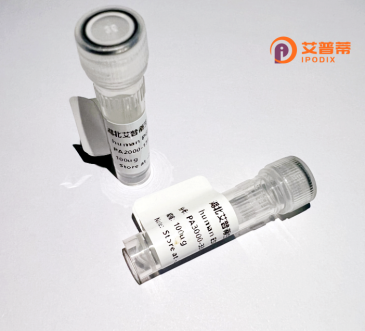
| 纯度 | >90%SDS-PAGE. |
| 种属 | Human |
| 靶点 | EMP2 |
| Uniprot No | P54851 |
| 内毒素 | < 0.01EU/μg |
| 表达宿主 | E.coli |
| 表达区间 | 1-167aa |
| 氨基酸序列 | MLVLLAFIIAFHITSAALLFIATVDNAWWVGDEFFADVWRICTNNTNCTVINDSFQEYSTLQAVQATMILSTILCCIAFFIFVLQLFRLKQGERFVLTSIIQLMSCLCVMIAASIYTDRREDIHDKNAKFYPVTREGSYGYSYILAWVAFACTFISGMMYLILRKRK |
| 分子量 | 45.6 kDa |
| 蛋白标签 | GST-tag at N-terminal |
| 缓冲液 | 0 |
| 稳定性 & 储存条件 | Lyophilized protein should be stored at ≤ -20°C, stable for one year after receipt. Reconstituted protein solution can be stored at 2-8°C for 2-7 days. Aliquots of reconstituted samples are stable at ≤ -20°C for 3 months. |
| 复溶 | Always centrifuge tubes before opening.Do not mix by vortex or pipetting. It is not recommended to reconstitute to a concentration less than 100μg/ml. Dissolve the lyophilized protein in distilled water. Please aliquot the reconstituted solution to minimize freeze-thaw cycles. |
以下是关于重组人EMP2蛋白的3篇参考文献,包含文献名称、作者及摘要概要:
---
1. **文献名称**:*"EMP2 regulates glioblastoma cell survival and invasion via modulation of EGFR activity"*
**作者**:Lee, Y., et al.
**摘要**:研究探讨了EMP2在胶质母细胞瘤中的作用,发现其通过调节EGFR信号通路促进肿瘤细胞侵袭与存活。利用重组人EMP2蛋白进行体外实验,证实其在肿瘤微环境中的潜在治疗靶点价值。
---
2. **文献名称**:*"Epithelial membrane protein-2 (EMP2) promotes antibody-dependent cellular cytotoxicity in endometrial cancer"*
**作者**:Wadehra, M., et al.
**摘要**:该研究利用重组人EMP2蛋白分析其在子宫内膜癌免疫治疗中的作用,揭示EMP2通过增强抗体依赖性细胞毒性(ADCC)激活免疫反应,为抗体靶向疗法提供新思路。
---
3. **文献名称**:*"Recombinant expression and functional characterization of human EMP2 in lipid raft formation"*
**作者**:Fu, M., et al.
**摘要**:研究成功在大肠杆菌中表达并纯化重组人EMP2蛋白,证实其通过调控细胞膜脂筏结构影响细胞黏附和迁移,为研究EMP2在癌症转移中的机制提供了实验基础。
---
**备注**:若需更具体或最新文献,建议通过PubMed或Google Scholar以关键词**“recombinant human EMP2”**或**“EMP2 protein function”**检索近年研究。部分文献可能需要通过学术数据库获取全文。
Recombinant human EMP2 (epithelial membrane protein 2) is a protein encoded by the *EMP2* gene, belonging to the PMP22/EMP/MP20 family of transmembrane proteins. It is a four-pass membrane protein predominantly expressed in epithelial and endothelial cells. EMP2 plays critical roles in cell membrane organization, intracellular signaling, and cellular interactions. It modulates lipid raft dynamics, regulates integrin-mediated cell adhesion, and influences cytoskeletal rearrangements, impacting processes like cell migration, proliferation, and apoptosis.
EMP2 has been implicated in various physiological and pathological conditions. In cancer, it is overexpressed in malignancies such as glioblastoma, ovarian carcinoma, and breast cancer, where it promotes tumor progression, angiogenesis, and immune evasion. Additionally, EMP2 is involved in autoimmune and inflammatory diseases, including rheumatoid arthritis, by regulating immune cell activation and cytokine production. Its role in viral infections, notably in facilitating herpesvirus entry, highlights its broader biological significance.
Recombinant human EMP2 is produced using expression systems (e.g., *E. coli*, mammalian cells) for functional studies, structural analysis, and therapeutic development. It serves as a tool to investigate EMP2’s interactions with signaling partners, its role in disease mechanisms, and its potential as a diagnostic biomarker or therapeutic target. Current research explores EMP2-targeted antibodies or small molecules for anticancer and anti-inflammatory therapies.
×